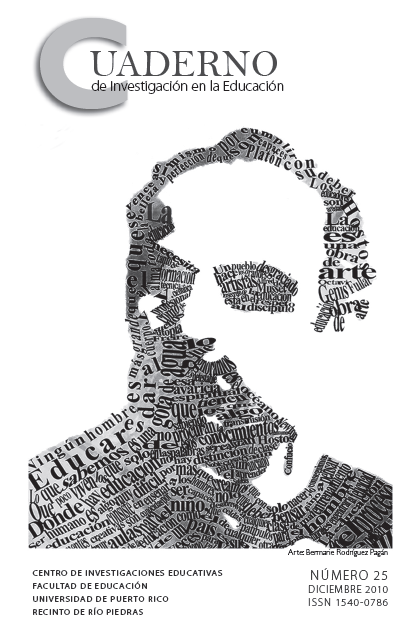Abstract
This article analyses the attitudes towards the study of mathematics of university students from the Business Administration School enrolled in introductory Quantitative Methods courses. Given the relationship between quantitative literacy and professional performance in this area, study skills, perceptions of the importance of mastering basic mathematical skills and availability of academic support are also studied and compared. In general it was found that students lack good study strategies, and that a high percentage of them do not use the available academic assistance. A mentoring program is presented as an alternative to provide students with support in developing adequate mathematical and learning skills, and also with motivation and guidance with respect to their professional future.
How to cite:
Álamo, M. (2010). Diseño de un Programa de Mentoría para promover el desarrollo de destrezas matemáticas en el estudiante de la Facultad de Administración de Empresas. Cuaderno de Investigación en la Educación, 25, 51-74. Retrieved from https://revistas.upr.edu/index.php/educacion/article/view/13535
References
American Institutes for Research. (2006). New study of the literacy of college students finds some are graduating with only basic skills. Recuperado de http://www.air.org/news/documents/release200601pew.html
Hsu, E., Murphy, T., & Uri, T. (2008). Supporting high achievement in introductory mathematics courses: What we have learned from 30 years of the Emerging Scholars Program. En M. Carlson, & C. Rasmussen (Eds.), Making the connection: Research and teaching in undergraduate mathematics education (pp. 205-220). Washington, DC: Mathematical Association of America.
Hughes D. (2003). The role of mathematics courses in the development of quantitative literacy. En B.L. Madison & L.A. Steen (Eds.), Quantitative literacy: why numeracy matters for schools and college (pp. 91-98). Recuperado de http://www.maa.org/Ql/pgs91_98.pdf
Kasunic, M. (2005). Designing an effective survey (CMU/SEI-2005-HB-004). Recuperado de http://www.sei.cmu.edu/reports/05hb004.pdf
Kramer, G. (2003). Faculty advising examined: Enhancing the potential of college faculty as advisors. San Francisco: Jossey-Bass.
Kuh, G., Kinzie, J., Schuh, J., & Whitt, E. (2005). Student success in college: Creating conditions that Matter: San Francisco: Jossey-Bass.
Light, R. J. (2001). Making the most of college: Students speak their minds. Cambridge, MA: Harvard University Press.
Murray, M. (2001). Beyond the myths and magic of mentoring. San Francisco: Jossey-Bass.
National Mentoring Partnership. (2005). Introducción a la mentoría y la construcción de un programa. Recuperado de http://www.mentoring.org
National Council on Education and the Disciplines (2000). The case for quantitative literacy - A working draft. Recuperado de http://www.stolaf.edu/other/ql/case.html
Oficina de Planificación Académica. (2008). Libro de datos estadísticos. San Juan, PR: Universidad de Puerto Rico. Recuperado de http://opa.uprrp.edu/saga.htm
Organization for Economic Co-operation and Development (2007). The Programme for Internacional Student Assesment (PISA) 2006: Science competencies for tomorrow‘s world. Recuperado de http://www.pisa.oecd.org/dataoecd/15/13/39725224.pdf
Sánchez, C., Almendra A., & Macías J. (2004). Proyecto Mentor Primero y Proyecto Mentor ERASMUS en la E.T.S.I. de Telecomunicación de la Universidad Politécnica de Madrid. Recuperado de http://wwwgth.die.upm.es/research/documentation/AG-32Pro-04.pdf
Sistema de Información Estudiantil. (2008). Recuperado de http://opa.uprrp.edu/saga.htm.
U.S. Department of Education National Center for Education Statistics (2007). The nations report card: Mathematics 2003 and 2005- Performance in Puerto Rico. Recuperado de http://nces.ed.gov/nationsreportcard/pdf/studies/2007459.pdf
U.S. Department of Education (1998). Yes you can: A guide for establishing mentoring programs to prepare youth for college. Recuperado de http://www.ed.gov/pubs/yesyoucan
The contents published in the Puerto Rico Journal of Education is freely distributed under open access practices, in accordance with the Creative Commons license, Attribution-NonCommercial 4.0 International (CC BY-NC 4.0). Through these principles, the journal and its authors allow readers to access, reproduce and share articles in full text. Users should give credit to authors in a reasonable way without suggesting they have their support. Under no circumstances, readers may make use of the contents for commercial purposes. The authors retain copyright on their works.

